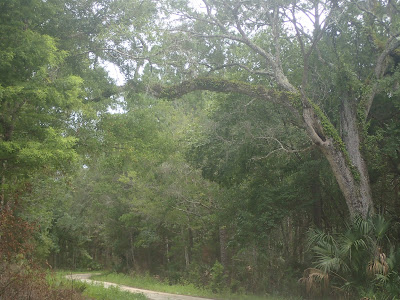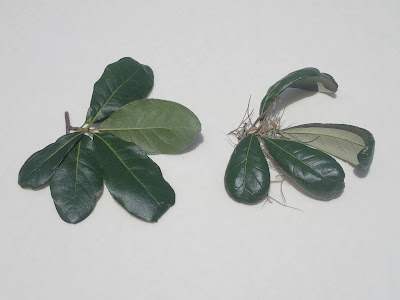Trees of the Lower Suwannee Region: A Natural History
Part III. Southern Live Oak – A Competitor
Florida’s lower Suwannee River and Cedar Keys region,
including extensive conservation lands and two outstanding National Wildlife Refuges, boasts more species of
trees—as many as 130—than all but a few places in North America. Some of our
trees are widely distributed in eastern North America, some are restricted to
the southeastern coastal plain, and others reach their greatest prominence locally.
A few years ago, our Friends of the Lower Suwannee and Cedar Keys National
Wildlife Refuges organization designed a tee-shirt featuring six iconic species
of trees occurring on the refuges. Our series of blog posts will begin by
considering each of these six species. This, the third installment, focuses on
southern live oak. Some of the information in this post may repeat or overlap
with last November’s post about the 17 species of oaks occurring in our
neighborhood. That post can be found here.
Southern Live
Oak (Quercus virginiana) is best known to people as the huge spreading
trees often seen widely spaced in open fields throughout the southeast. Also
memorable are the often-gigantic specimens seen along streets in the
historic districts of southern cities and towns. This indeed is its common
habit when grown in full sun, but southern live oak also occurs as a true
forest species. When it occurs in forested surroundings it is often more erect,
still branching, but reaching toward the forest canopy. Sometimes these trees
might not be seen at all if it were not for the huge branches arching upward.
So, even though the iconic image of the spreading, moss-draped oak that appears
on our tee shirts represents a southern live oak, the image shown is unlikely
to be often mirrored in the natural habitats of the refuges.
Southern live
oak is moderately shade tolerant, and it shares dominance in certain climax communities with southern magnolia (Magnolia
grandiflora); more about magnolia later and what it means to be a climax
forest in this part of Florida. Southern live oak is long-lived, persistent in
forest canopies, and slow to reproduce. These qualities relate in part to its
shade tolerance, but other adaptations are at work.
Owing to its
extraordinary strength the wood of live oaks was much valued in the
construction of wooden ships. Live oak planking became legendary during
the Revolutionary War when “Old Ironsides”—the USS Constitution—was reported to
repel British cannonballs. Another use of live oak in ship building involved employing
bent limbs as pre-formed internal braces after these extra strong pieces were
milled down to fit. In the age of wooden warships live oak trees were
considered strategic materials and were provided with governmental protection.
 |
| Live oak along the Lower Suwannee refuge's Nature Drive. Along portions of the southern half of the Nature Drive old live oak trees arch over the roadway. |
One place on
the Lower Suwannee refuge to see some impressive specimens of southern life oak
is on the southern half of the Nature Drive, beginning at the
junction of the drive with Cabin Road and continuing to the Barnett Creek Road. Massive old live oaks in some places arch completely over
the road. This part of the road traverses mesic (wet) areas and in some places comes
quite close to tidewater. Along some of this stretch occasional damage from
storm surges accompanying hurricanes is likely. Construction of the road,
probably in the early twentieth century, disrupted the normal hydrology,
resulting in roadside ditches and possible drying of nearby areas. Other kinds
of disturbance may have occurred, but the oaks have persisted. They appear not to
have been heavily logged, and most commercial logging done locally focused on
pines in the uplands and cypresses in the river bottoms.
Another species of oak in our area is the closely related sand live oak (Q. geminata). Even more restricted to the southeastern coastal plain, this species is generally smaller and more adapted to drought. Some authorities, including the U.S. Forest Service consider Q. geminata to be a subspecies of Q. virginiana, but this seems doubtful as the two often occur side by side throughout our area. Conceivably the two species might hybridize, but they rarely do so because southern live oak flowers earlier than sand live oak. Sand live oaks can become quite large in favorable conditions, and those in the wetter Gainesville area vie with southern live oaks in size.
A third species
of live oak, the already mentioned dwarf live oak (Q. minima) also occurs locally but is far
different in its appearance and ecology from the other two. Not a tree in the
normal sense, Q. minima has tiny above ground parts, usually less than a foot
tall, and it occurs as a ground cover in fire-maintained flatwoods habitats.
Sand ridges
throughout the Lower Suwannee refuge and coastal islands support scrubby oaks, many of which are sand live oak. They are often joined by myrtle oak (Q.
myrifolia), also a small to medium size tree. Where fires are frequent,
both may occur as shrubby thickets, in extreme instances producing
so-called clone domes. A third oak, Chapman’s oak (Q. chapmani) is frequently
present also. Although often a small tree, Chapman’s oak is more often shrub
like. These three oaks are adapted to dry conditions and on the refuge may seen along
State Road 247 in high spots where the road undulates over a series of old sand
dune. Others are visible along the headquarters entrance road just beyond the
bat house.
Southern live oaks, sand live oaks, and dwarf live oaks may occur in relatively close proximity, occupying often nearby sites that differ in available moisture and frequency and intensity of fires. Southern live oak requires relatively mesic conditions that are not subject to frequent, hot fires. Sand live oaks are most common in drier sites with occasional hot fires that may damage or destroy all above-ground parts. Dwarf live oak commonly occurs in flatwoods sites that are subject to frequent low-intensity fires.



